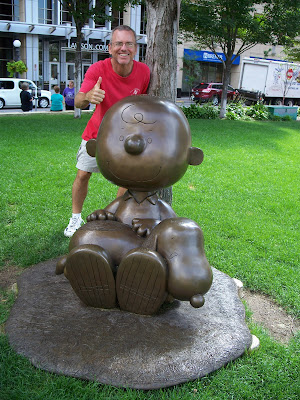
August 14, 2010
We stopped back at Aztec to see the movie, peruse the exhibits and take a quick run thru the ruins again. I was a little miffed at how PC the park has gotten. Half the artifacts in the museum had been removed because local Indians claim the relics are either burial items or are sacred to them and should not be on display for white people. Also apparently the rangers can’t say these sites were abandoned anymore because the Indians say their dead ancestors’ ghost still reside there. All the local tribes claim to be descendents of the Anasazi. Even the Navajo who didn’t migrate into the region until 1700.
From Aztec we drove an hour south intending to go to Chaco Culture Historic Park. We turn off the main road and drive five miles when we come to the beginning of the 13.5-mile dirt road that leads to Chaco. It is washboard. I initially try to fly over it at 35 mph. That works for a mile but then we hit a bad section and I think our home is going to shake apart violently. Aimee threatens divorce if I don’t turn around. I agree with her but the road is too narrow for me to do a three-point turn. When I do find a turnout, we discuss the options and none are any good. Instead we agree to drive 5-10 miles an hour and make the best of it. We hit really bad spots a couple more times and consider turning around each time. Eventually we make it thru to park property and find paved road again. Hallelujah!

I suffered thru this drive because I have heard a lot about Chaco Canyon. The Anasazi are often described as a Chaco culture. It is supposed to be a very interesting park. We were not disappointed. The park lies at the bottom of a broad steep-sided canyon. Along its length are the ruins of a half dozen monumental-sized pueblo structures. Most of these “Great Houses” are of a similar structure (like Aztec). They are D-shaped with 600++ rooms and kivas each.

Roads radiate from this canyon in all directions to the other regional pueblos implying Chaco was the center of something. Like Aztec scientists believe few people lived here. The archeologists provide no good answers in my mind for the purpose of these huge pueblos. They could be religious or governmental structures or possibly trading centers with hotels rooms for visiting traders. Because local Indians say they are sacred places, the park seems to favor the religious option.
The Visitor Center is being renovated so we start off driving the loop road stopping to tour five of the pueblos. At the oldest site we take a guided ranger tour. (The only one offered in the afternoon) This volunteer is pretty good but makes me wonder what the six staff interpretative rangers do all day to earn their salary.

Afterwards we take a fun hike up a crack in the canyon wall and along the rim for a great overlook of the main pueblo. Along the way we even spot a few fossils in the rocks as a bonus. Since we are many miles (and several hours) from civilization, we spend the night at the primitive park campground at the base of the canyon wall. We have spent the night amidst giant boulders, under monster redwoods, on cliff edges, and alongside rivers, lakes, and oceans, but this is the first time we have camped next door to an Anasazi ruin (albeit a small minor one). Pretty cool!
 August 16, 2010
August 16, 2010




























